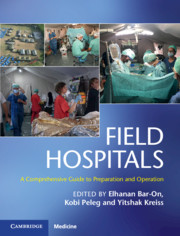Book contents
- Field Hospitals
- Field Hospitals
- Copyright page
- Contents
- Contributors
- Preface
- Section 1 History
- Section 2 Scenarios
- Section 3 Operational Considerations
- Section 4 Clinical Considerations
- Section 5 Additional Contextual Considerations
- Chapter 29 Forensic Medicine and Victim Identification in the Field Hospital Setting
- Chapter 30 Prehospital Care in the Disaster Setting
- Chapter 31 Long-term Deployment and Continuity of Care
- Chapter 32 Ethical Dilemmas in Field Hospital Deployments
- Chapter 33 Legal Issues in Field Hospital Deployments
- Index
- Plate Section (PDF Only)
- References
Chapter 30 - Prehospital Care in the Disaster Setting
from Section 5 - Additional Contextual Considerations
Published online by Cambridge University Press: 09 January 2020
- Field Hospitals
- Field Hospitals
- Copyright page
- Contents
- Contributors
- Preface
- Section 1 History
- Section 2 Scenarios
- Section 3 Operational Considerations
- Section 4 Clinical Considerations
- Section 5 Additional Contextual Considerations
- Chapter 29 Forensic Medicine and Victim Identification in the Field Hospital Setting
- Chapter 30 Prehospital Care in the Disaster Setting
- Chapter 31 Long-term Deployment and Continuity of Care
- Chapter 32 Ethical Dilemmas in Field Hospital Deployments
- Chapter 33 Legal Issues in Field Hospital Deployments
- Index
- Plate Section (PDF Only)
- References
Summary
This chapter describes the role of prehospital teams deployed to large scale disaster events. It describes two categories of type I emergency medical teams (EMT), and provides an overview of their capabilities and expectations. It reviews competing models of prehospital care delivery that are prevalent worldwide, including the levels of service that can be expected within such systems. Finally, the chapter describes the role of the medical component of urban search and rescue (USAR) teams, and notes the differences that exist between type I EMTs and USAR teams. Future trends in the development of EMTs are explored, including the importance of national capacity building, the commitment to acute and long term community needs, and the continued promotion of EMT and USAR medical coordination.
Keywords
- Type
- Chapter
- Information
- Field HospitalsA Comprehensive Guide to Preparation and Operation, pp. 290 - 296Publisher: Cambridge University PressPrint publication year: 2020



